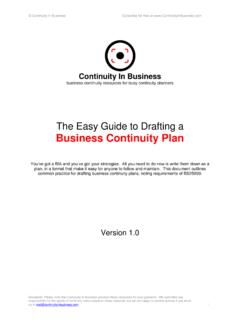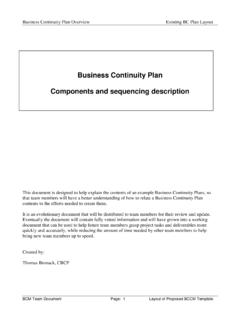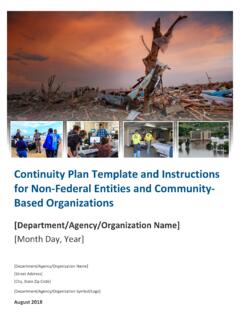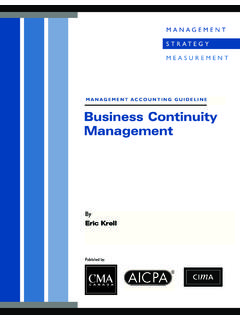Transcription of Best practices in business continuity - Pitney Bowes US
1 1 How planning for the worst can be the best thing for your businessBest practices in business continuityWHITE PAPER2 best practices in business continuityHow planning for the worst can be the best thing for your businessCompany-wide commitment makes a differenceThe commercial fire at the Pitney Bowes facility provides an excellent example of business continuity in action. Unexpected disasters can have a calamitous impact on business , but if you prepare well, the impact can be minimized. All it takes is commitment and are unpredictable and random. Whether it s the wrath of Mother Nature delivered via earthquakes in Japan, New Zealand and Haiti, or man-made like the 9/11 attacks or simple accidents, disasters can result in chaos. A detailed business continuity Plan can make the difference between quick and successful navigation of disruption or a lengthier and often costly recovery.
2 By preparing for the worst, you just might be ensuring your survival. Just what is business continuity Planning?It is more than a buzzword. In the post-9/11 world, business continuity Planning is now baked into corporate security planning, as businesses must keep functioning in the midst of all sorts of disruptive events. The primary goal of business continuity Planning is to help organizations stay in business by minimizing the impact upon clients, establish contingency plans to limit the impact of damage and mitigate losses. It s more holistic than Disaster Recovery, because it looks not just at the event and its immediate aftermath, but at the implications of many potential scenarios. business continuity Planning provides a comprehensive, long-term approach involving not just data and IT infrastructure contingencies, but also planning for disruptions to physical plant or facility, materials and equipment.
3 For companies in the service sector, business continuity Planning also includes protecting customer data, inventory, and 7, 2011. GRAND PRAIRIE, TX. 7:45 detectors are tripped at a Pitney Bowes mail services presort facility as a fire that started in a nearby facility rapidly spreads. At 4:30 , it grew to a four-alarm blaze and continued to rage through the night, damaging millions of dollars of equipment. By 9 , the entire facility where employees served hundreds of commercial customers is totally unexpected can happen to any organization, at any time. While you cannot control the unexpected, you can control how you the case of the fire described above, the response had been drawn up months earlier. As a result, on the morning after the fire, trucks started their routes, picking up mail from customers throughout the Dallas/Fort Worth area. Mail was presorted at a second Pitney Bowes facility in the same vicinity as well as other sites in the region to maximize postal discounts; then barcoded, bagged, trayed and prepped to ensure rapid induction and delivery.
4 In many ways, service continued without ability to overcome a disaster to serve customers is due in part to the unique attributes of the Pitney Bowes mail services network. With 36 operational facilities, Pitney Bowes could redirect workflow based on specific customer needs and classes of importantly, however, Pitney Bowes had designed, documented and tested a formal business continuity Plan. As a result, local management knew exactly what needed to be done to safeguard employees, secure the building, protect customer data, reroute the mail, and make every customer pickup and delivery as scheduled that day, the next week and in the months that search began immediately for a new mail presort facility. Frequent, informative communications to customers continued long after the initial disaster. There were no breaches of customer security. Insurance claims were in the works within 30 days.
5 Customers were reassured and confident that Pitney Bowes could continue to deliver service excellence, despite the Pitney Bowes white paper provides insights into the business continuity Planning process, so other service organizations can learn from this event and take steps to safeguard and strengthen their own operations. According to the Centre for Research on the Epidemiology of Disasters, between 2000 and 2008, there were on average 392 disasters per year and the average annual economic damage was $ billion reasons to implement business continuity Planning1 Keep revenue flowing; Keep basic communications up (e-mail, IM, phone); Keep customers engaged and happy (Web site, service, shipping); and Track the transactions (billing and accounting).1. Overland Storage, A Practical Guide to business continuity , 20103 best practices in business continuityHow planning for the worst can be the best thing for your businessThe document further defines emergency response protocols and the recovery point objective, or when the recovery mission is deemed complete.
6 This is crucial for the long-term health of a business , particularly service businesses, as the customer is the ultimate arbiter of when service is back to normal. The business continuity Plan should establish communications guidelines and service levels that will enable staff to effectively manage customer expectations throughout the disaster and its aftermath. As data integrity is the backbone of many service organizations, sections on information technology planning and recovery must detail procedures for backing-up data and designating alternative sites for housing data. If the need is great enough, as in the financial services industry, duplicate systems are often created off-site, ready for deployment at a moment s notice. The final part of the plan development is annual training. All persons involved, from the executives down through the on-site implementation team, must review the plan at least annually.
7 Remember, organizational structures and personnel change all of the time, and new team members need to fully understand their current role. Executive management needs to sign off on the plan, empowering the management team to rapidly respond to the disaster that is at hand. The plan must be rigorously tested under conditions as realistic as possible. Each facility needs to designate an owner for that site s business continuity Implementation Team. Start by acknowledging your needs and vulnerabilitiesAccording to a recent Forrester report, almost a quarter of companies are likely to declare a disaster in a five-year time onset of a disaster is not the time to plan. Rather, smart businesses take a proactive stance, from the CEO on down, making business continuity a priority for the entire organization. The process involves management, IT, operations, logistics, real estate, legal, risk management, HR, sales and marketing all working together to develop an integrated plan, giving everyone a stake in that plan s success.
8 When disaster strikes, everyone starts from the same are three key phases of business continuity : the plan, the implementation and the 1: The planA business Impact Analysis covers all aspects of the business and is usually initiated by top management. This analysis involves cross-departmental teams identifying the business s most critical systems and processes and the potential effect a disaster would have on each area. A thorough risk assessment would also include an inventory of the entire business , the facilities, and, for each facility, the people, the equipment, the software, and the relevant data housed analysts would then explore what could happen, imagining as many disaster scenarios as possible, hypothesizing how to handle each of those scenarios, and prioritizing the risks inherent in each. The scenarios should include the domino effect, when more than one thing goes wrong.
9 The recent earthquake in Japan is a case in point. First Japan had an earthquake; then a tsunami, followed by a nuclear disaster. The business Impact Analysis helps determine the sequence of activities, identifying which services should be restored complete, a written business continuity Plan provides a highly detailed, step-by-step primer on what to do, when to do it, whom to bring in, and how to follow through. The best plans include simple checklists and priorities that are easy to follow when individuals find themselves in stressful emergency situations. Since staff turnover is an ongoing issue, the business continuity Plan must be written by job function rather than by name of Forrester Research, Inc. Wake-Up Call: You Aren t Ready For A Disaster, February 9, in Point: Pitney Bowes Mail ServicesThe general manager of the presort services facility in the Dallas/Fort Worth area was well versed in business continuity Planning when disaster struck on the night of February 7, 2011.
10 The Pitney Bowes 41-page business continuity Plan had been updated and tested months earlier and included detailed work flows, task lists, contacts, network configurations, technology specs, necessary documents, contingency plans and communication plans for both employees and customers. Thanks to the recent plan testing and updates, all employee lists, customer phone numbers and e-mail addresses were correct and practices in business continuityHow planning for the worst can be the best thing for your businessThe Pitney Bowes example demonstrates ten best practices during the implementation phase:1. Ensure employee safety. Employees are a business s most valuable resource. Follow proper safety procedures for evacuation in the event of a fire or natural disaster, making sure that everyone is out of the building and at a safe distance. Perform a physical headcount to verify that no one has been left behind.












